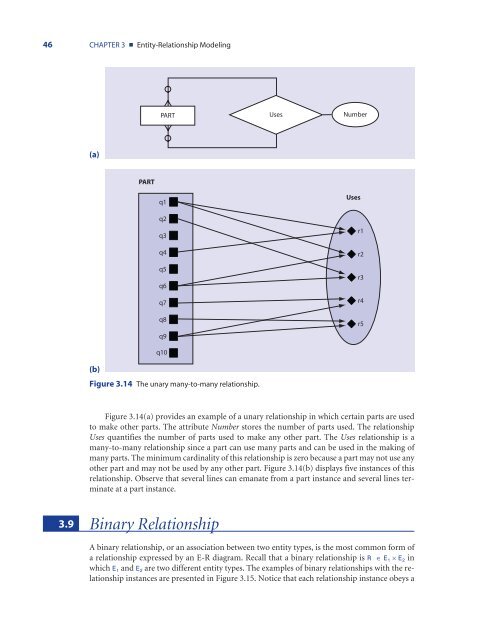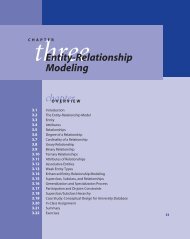Web-DSS-Chapter-03
Web-DSS-Chapter-03
Web-DSS-Chapter-03
You also want an ePaper? Increase the reach of your titles
YUMPU automatically turns print PDFs into web optimized ePapers that Google loves.
46 CHAPTER 3 ■ Entity-Relationship Modeling<br />
PART<br />
Uses<br />
Number<br />
(a)<br />
PART<br />
q1<br />
q2<br />
q3<br />
q4<br />
q5<br />
q6<br />
q7<br />
q8<br />
q9<br />
q10<br />
(b)<br />
Figure 3.14 The unary many-to-many relationship.<br />
Uses<br />
r1<br />
r2<br />
r3<br />
r4<br />
r5<br />
Figure 3.14(a) provides an example of a unary relationship in which certain parts are used<br />
to make other parts. The attribute Number stores the number of parts used. The relationship<br />
Uses quantifies the number of parts used to make any other part. The Uses relationship is a<br />
many-to-many relationship since a part can use many parts and can be used in the making of<br />
many parts. The minimum cardinality of this relationship is zero because a part may not use any<br />
other part and may not be used by any other part. Figure 3.14(b) displays five instances of this<br />
relationship. Observe that several lines can emanate from a part instance and several lines terminate<br />
at a part instance.<br />
3.9 Binary Relationship<br />
A binary relationship, or an association between two entity types, is the most common form of<br />
a relationship expressed by an E-R diagram. Recall that a binary relationship is R ∈ E 1 × E 2 in<br />
which E 1 and E 2 are two different entity types. The examples of binary relationships with the relationship<br />
instances are presented in Figure 3.15. Notice that each relationship instance obeys a



